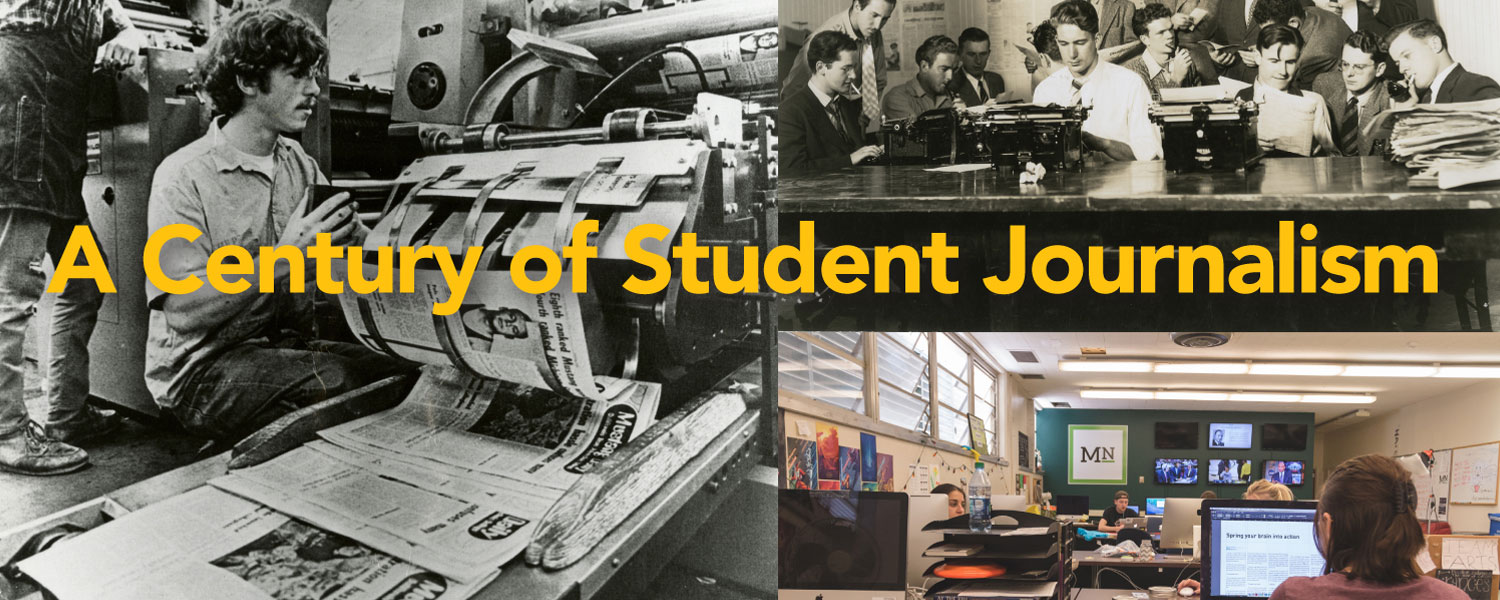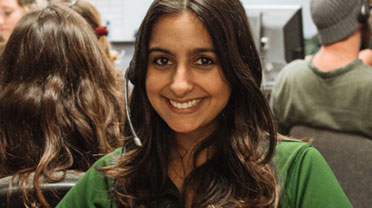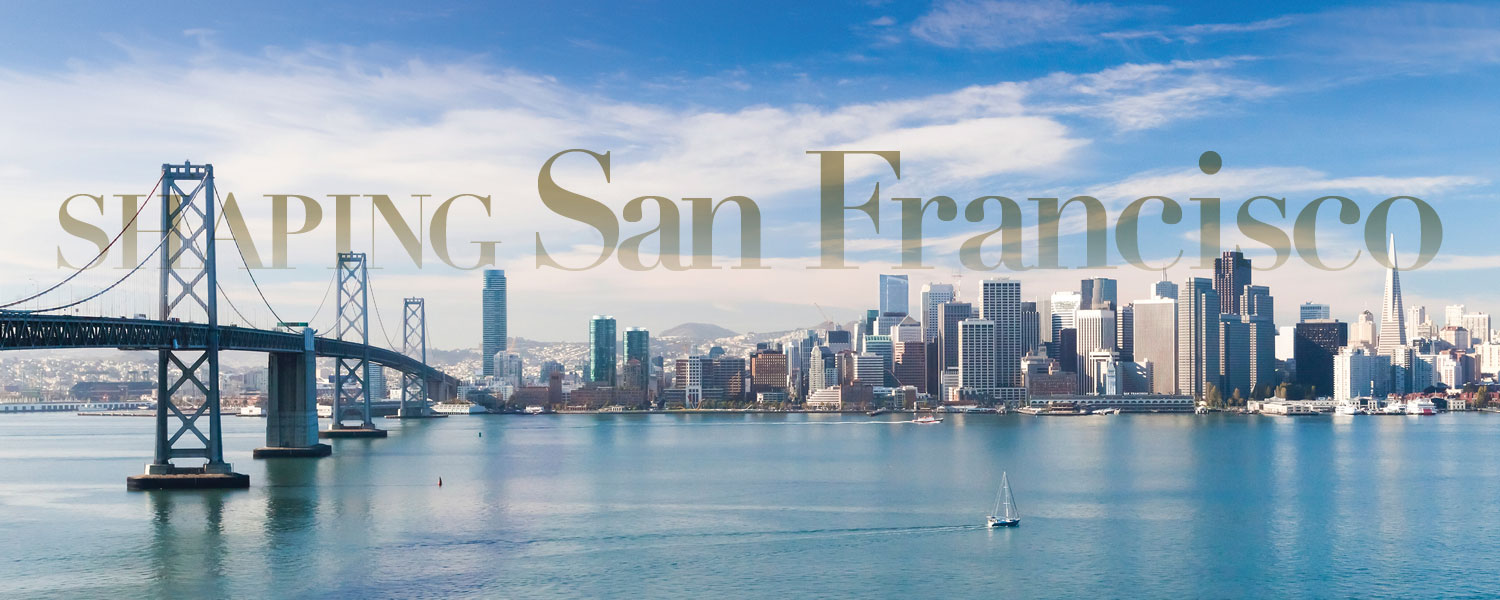By Rachel Ellersieck
If you walked into the Mustang News newsroom today, you would see a wall of flat-screens broadcasting 24-hour news and student reporters showing each other videos on their smartphones. You’d hear editors yelling questions across the room and the light clicking of Mac keyboards. The scene was much different when the first issue of the Polygram was published in April of 1916.
Editors of the first Polygram worked amid the clatter of manual typewriters, on which they produced the four-page newsletter that started it all. The first issue contained four pages of sports scores, jokes and short stories written by students. “‘Mick’ Gates and ‘Flakie’ Kellogg were pleased to receive a visit from their folks last week” was a typical headline. Of course, a lot has changed since then, and as Cal Poly student media turns 100 this year, past editors reflected on their time at the newspaper.
By the time Alton Pryor joined the paper in the late 1950s, it had survived two world wars and had been renamed El Mustang. Cal Poly was an all-male university at that time and type was still set by Linotype machines. “I learned a lot about newspaper layout, type sizes and fonts,” said Pryor, who eventually became an author and publisher. “I found that information valuable when laying out my books.”
He says his favorite El Mustang memory occurred after he graduated in 1958. “I was working for United Press International, which was located in the State Capitol Building in Sacramento,” he said. “Early in my shift one day, who should pop in but Cal Poly President Julian McPhee. He was in the Capitol to lobby the legislators, but he made a special effort to look in on me.”

The staff of the student TV station filming a news segment, date unknown. Image from University Archives
Twenty years later, the newspaper was called Mustang Daily, and Peter King was the editor. King remembers the newsroom as a messy space with an eclectic mix of students. Many students at that time were vets returning from Vietnam, so the age span was wider than normal. He said the staff was full of characters, which sometimes gave the room a zoo-like quality. “But it was fun and energizing,” he said. “That place was our home away from home. It was where we worked and where we partied.”
King now reports for the Los Angeles Times and says the beauty of Mustang Daily was that it allowed him to make and learn from mistakes. “For one issue, I had the bright idea to do a Q&A with the university’s president,” he said. President Robert E. Kennedy agreed under two conditions: he wanted all the questions in writing ahead of time, and the paper had to print his responses in full. King typed out his questions on a typewriter and marched them over to the President’s House on a Saturday morning — there was no email then.
A few days later he got the response. “Kennedy wrote so much, he basically held the paper hostage for two weeks,” said King. Kennedy was a journalist himself, and King believes he may have been teaching the rookie a lesson: never make promises or give editorial control away.
Fast-forward another 20 years to 1998 and Josie (Miller) Oldenburg was editor-in-chief. Mustang Daily gave her opportunities to try aspects of journalism that she otherwise might not have attempted. Another editor’s broken arm, for instance, led her to give page design a try. “The paper had to get out each day, so if that meant stepping in to do a job that we’d never before attempted, we did it,” she said. “That’s a skill that comes in handy throughout life, not just in journalism.”
Join the Celebration
On Oct. 14 and 15, 2016, Mustang News is celebrating 100 years of delivering the news — and you’re invited to join the party! Visit journalism.calpoly.edu to update your contact information and let us know all the ways you were involved in student media, whether it was writing stories for El Mustang, selling ads for the Mustang Daily, printing Mustang News, reporting on the air for CPTV or KCPR, or representing clients in CCPR. You’re all a part of this celebration!
The Mustang News archives are now available online, thanks to the staff of Kennedy Library’s Special Collections and Archives. Search past issues by date, byline or topic at digitalcommons.calpoly.edu/studentnewspaper.
Read more stories of Mustang News alumni
and learn more about the upcoming events at
MustangNews.net/anniversary.
She remembers a time when a student writer falsified a story and, unfortunately, the team of editors didn’t catch it until after it was published. “We were all deeply committed to printing the truth. We were shocked, offended and frankly, angry,” she said. “But rather than blaming or shaming each other, the editors came together to push for appropriate disciplinary measures, to rectify the situation, and to try our best to only publish the truth going forward.”
Immediately after graduating, Oldenburg worked at the Desert Sun in Palm Springs, Calif., as a copy editor and page designer, and then at the Orange County Register in the same capacities. “Mustang Daily prepared me very well for working at a professional newspaper,” she said. “In addition to editing and writing experience, I also learned to respect deadlines and the penalty for missing them. I learned how to focus in a chaotic environment. I learned to be proud of publishing exceptional work and how to bounce back after printing an embarrassing error.”
Fifteen years after Oldenburg was at the helm, Brian De Los Santos took over the Mustang Daily. Spending 20 hours in the newsroom each week between classes was a grind, he said — but it was time he enjoyed with his colleagues. “It was really cool to be surrounded by people who were like-minded in their interests and career goals,” he said. “Everyone I worked with in my last year had this passion for storytelling and for editing.”
Like King and Oldenburg, De Los Santos also appreciated Mustang Daily as a Learn by Doing experience. “I’ll grant that it’s a student publication, but the stories you’re editing are very real with very real ramifications,” he said. “To expose yourself to that kind of thought process early on in your career really helps.” De Los Santos graduated in 2013 and is now an editor at Mashable.com.
Shortly after De Los Santos graduated, the newspaper was renamed Mustang News. Today it prints twice a week with a heavier emphasis on digital storytelling, including a website featuring frequent video updates, a Facebook page, and a Twitter feed. The news industry has changed over the past 100 years, and Cal Poly’s student media has kept up along the way.
But some things never changed. Regardless of where they came from, what they studied, the decade they worked in or where they went after graduation, Mustang News alumni have always worked to create the best product they could. Dozens of awards hang on the wall to prove it. “Communities get the newspaper they deserve,” said Peter King. “Cal Poly is such a special place; the newspaper has always reflected that.”
Interviews were conducted jointly with the Mustang News staff, with reporting by journalism students Sabrina Thompson and Savannah Sperry.






